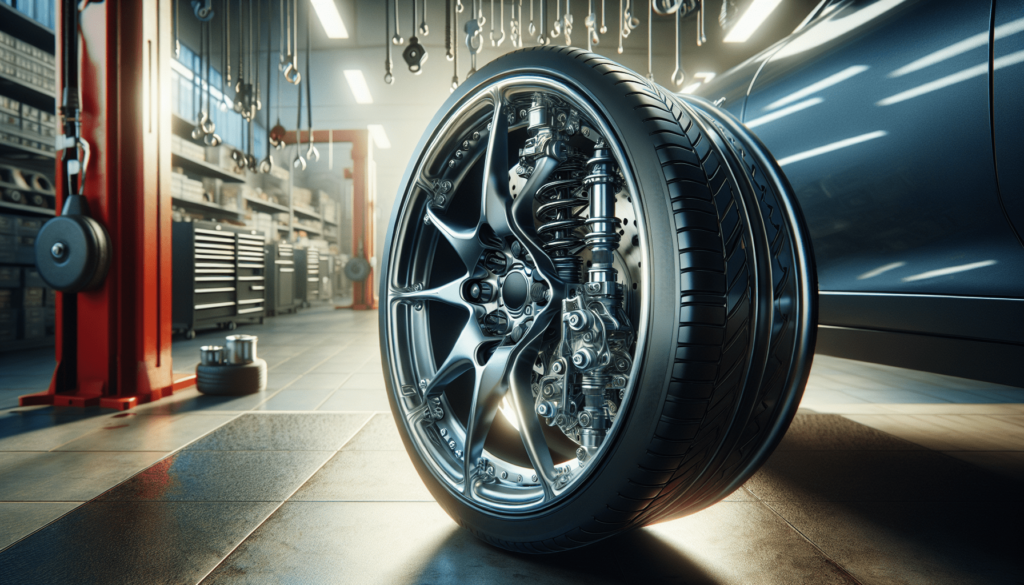Are you curious about the impact of wheel alignment on your vehicle’s suspension geometry? The alignment of your wheels plays a crucial role in maintaining the smooth operation of your suspension system. A misalignment can lead to various issues, such as uneven tire wear and a decrease in overall handling performance. In this article, we will explore the relationship between wheel alignment and suspension geometry to understand why proper alignment is vital for the optimal performance of your vehicle.

How Wheel Alignment Works
Camber Angle
The camber angle refers to the tilt of the wheels when viewed from the front or rear of the vehicle. If the top of the wheel is leaning inward, it is called negative camber, while if it is leaning outward, it is positive camber. The camber angle affects the contact patch of the tire with the road surface, impacting the vehicle’s handling and tire wear.
Toe Angle
The toe angle is the direction in which the wheels are pointed in relation to each other when viewed from above. If the wheels are pointed towards each other, it is called toe-in, and if they are pointed away from each other, it is called toe-out. The toe angle influences how the tires interact with the road during steering, affecting the vehicle’s stability and tire longevity.
Caster Angle
The caster angle is the backward or forward tilt of the steering axis when viewed from the side of the vehicle. It is responsible for the self-centering action of the steering wheel and provides stability during straight-line driving. A positive caster angle enhances steering response and stability, while a negative caster angle can lead to steering instability.
Suspension Geometry
Definition
Suspension geometry refers to the arrangement and interaction of various components within a vehicle’s suspension system. It includes the position, angles, and lengths of components like control arms, tie rods, and springs. Suspension geometry plays a crucial role in determining the behavior and performance of the vehicle on the road.
Components
The important components of a suspension system that contribute to its geometry include control arms, ball joints, struts, shock absorbers, springs, and sway bars. These components work together to provide support, stability, and control to the vehicle. Any changes in the suspension geometry can have a significant impact on the overall handling and performance of the vehicle.
Relationship between Wheel Alignment and Suspension Geometry
Effect of Camber Angle
The camber angle directly affects the suspension geometry. A proper camber angle ensures a balanced contact patch of the tire with the road surface, maximizing grip and reducing tire wear. A significant deviation from the recommended camber angle can result in uneven tire wear, reduced cornering stability, and compromised handling.
Effect of Toe Angle
The toe angle also has a direct impact on suspension geometry. The correct toe angle ensures that the wheels are aligned parallel to each other, promoting even tire wear and optimal handling characteristics. An incorrect toe angle can lead to accelerated tire wear, increased rolling resistance, and decreased stability during cornering.
Effect of Caster Angle
The caster angle is closely tied to the suspension geometry, affecting the steering and stability of the vehicle. A proper caster angle helps in maintaining steering stability and returning the steering wheel to the center position after a turn. Incorrect caster angles can result in steering difficulties, poor straight-line stability, and excessive tire wear.
Impact on Vehicle Handling
Steering Response
Wheel alignment directly influences the steering response of a vehicle. With proper alignment, the vehicle responds accurately to steering inputs, providing a smooth and controlled driving experience. Misalignment, on the other hand, can cause delayed or imprecise steering response, making it harder to maintain control of the vehicle.
Cornering Stability
Proper wheel alignment improves the cornering stability of a vehicle by ensuring that the tire contact patch is optimized for maximum grip. This allows the vehicle to negotiate turns with confidence and reduced risk of loss of control. Misalignment can lead to reduced cornering stability, making the vehicle more prone to understeer or oversteer.
Tire Wear
Wheel alignment plays a critical role in ensuring even tire wear. Proper alignment prevents irregular tire wear patterns, such as excessive wear on the inner or outer edges of the tire. Misalignment can cause rapid and uneven tire wear, reducing the lifespan of the tires and leading to increased replacement costs.

Symptoms of Misalignment
Irregular Tire Wear
One of the most common signs of misalignment is irregular tire wear. This includes excessive wear on the inner or outer edges of the tire, uneven tread wear, or feathering of the tread. If you notice any of these patterns on your tires, it is likely that your vehicle’s alignment needs attention.
Vehicle Drifting
When driving on a straight and level road, if your vehicle tends to drift to one side without any steering input, it could be a sign of misalignment. This drifting occurs when the wheels are not properly aligned, causing the vehicle to veer off its intended path.
Off-Center Steering Wheel
An off-center steering wheel is another indication of misalignment. When the wheels are properly aligned, the steering wheel should be centered or level when driving straight. If you notice that your steering wheel is not centered, it is a clear sign that your vehicle’s alignment needs adjustment.
Causes of Misalignment
Bumps and Potholes
Driving over bumps and potholes can cause misalignment by jolting the suspension system and knocking the wheels out of their proper alignment. The impact from these road irregularities can result in changes in the camber, toe, and caster angles, leading to misalignment.
Worn Suspension Components
Over time, the various suspension components can wear out or become damaged, leading to misalignment. Worn ball joints, control arms, or tie rod ends can cause the wheels to deviate from their correct alignment angles. Regular inspection and maintenance of the suspension components are essential to prevent misalignment issues.
Accidents or Collisions
Accidents or collisions can have a significant impact on the alignment of a vehicle. The force and impact from a collision can bend or damage suspension components, causing misalignment. Anytime you are involved in an accident, even a minor one, it is important to have your vehicle’s alignment checked.

Wheel Alignment and Suspension Maintenance
Regular Inspection
To prevent misalignment issues, regular inspections of the suspension system and wheel alignment are necessary. Professional technicians can check the alignment angles and identify any discrepancies. They can also inspect the suspension components for wear or damage and recommend repairs or replacements, if necessary.
Suspension Repairs
If any suspension components are found to be worn or damaged, they should be repaired or replaced promptly. This includes components like ball joints, control arms, tie rods, and shocks. By maintaining the integrity of the suspension system, the chances of misalignment are reduced, ensuring optimal vehicle performance.
Alignment Check
Having your vehicle’s alignment checked periodically is crucial for maintaining proper suspension geometry. Even if no symptoms of misalignment are present, an alignment check can identify any minor deviations and correct them before they escalate into major issues. It is recommended to have the alignment checked at least once a year or whenever the vehicle undergoes suspension or steering repairs.
Professional Wheel Alignment vs. DIY
Equipment and Expertise
Professional wheel alignment services use specialized equipment and trained technicians to accurately measure and adjust the alignment angles. They have the expertise to interpret the measurements and make precise adjustments to bring the wheels back into proper alignment. DIY alignment methods, on the other hand, lack the precision and accuracy of professional equipment and may not yield reliable results.
Precision and Accuracy
Professional wheel alignment ensures precise and accurate measurements, taking into account the specific requirements of each vehicle. They consider factors such as suspension design, vehicle weight distribution, and manufacturer specifications. DIY methods often rely on visual estimations or basic tools, which can result in inaccurate alignment adjustments and potential problems down the road.
Warranty
Professional wheel alignment services often offer warranties on their workmanship. This provides peace of mind knowing that if any alignment issues arise after the service, they will be rectified at no additional cost. DIY alignments do not come with such warranties, and any subsequent alignment problems would need to be addressed at the owner’s expense.

Benefits of Proper Wheel Alignment
Improved Handling and Safety
Proper wheel alignment enhances the handling and safety of a vehicle. With aligned wheels, the vehicle responds predictably to steering inputs, maintains stability during cornering, and minimizes the risk of skidding or loss of control. This greatly improves the overall driving experience and reduces the chances of accidents.
Extended Tire Life
Good wheel alignment significantly extends tire life. When the wheels are correctly aligned, the tires wear evenly, allowing them to reach their maximum lifespan. This reduces the frequency of tire replacements, saving you money in the long run.
Fuel Efficiency
Proper wheel alignment promotes fuel efficiency by reducing rolling resistance. When the wheels are aligned, there is minimum friction between the tires and the road, resulting in smoother movement and less energy wasted. This leads to improved fuel economy and reduced fuel consumption.
Conclusion
Importance of Wheel Alignment
Wheel alignment plays a vital role in maintaining proper suspension geometry, which directly affects the handling, stability, and safety of a vehicle. By ensuring that the camber, toe, and caster angles are within recommended specifications, wheel alignment optimizes tire wear, enhances steering response, and improves overall vehicle performance.
Impact on Suspension Geometry
Misalignment can negatively impact the suspension geometry, leading to irregular tire wear, compromised steering response, and reduced cornering stability. By understanding the relationship between wheel alignment and suspension geometry, you can recognize the symptoms, address the causes, and take the necessary maintenance steps to keep your vehicle properly aligned. Regular inspections, suspension repairs, and professional wheel alignment services are essential to ensure a smooth and safe driving experience for years to come.


